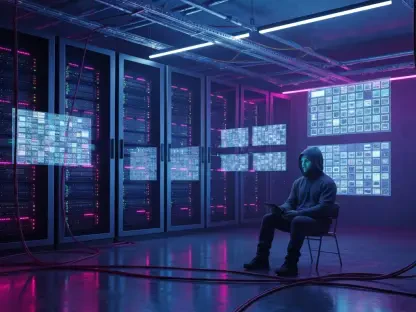In the fast-evolving world of retail technology, where digital presence can make or break a brand, the demand for high-quality, scalable 3D content has surged to unprecedented levels, creating a pressing need for innovative solutions. Retailers and creators grapple with the challenge of producing visually stunning assets for eCommerce, social media, and advertising without incurring prohibitive costs or delays. Enter B.THREE, a browser-based, AI-driven 3D content creation platform by SKAI Intelligence, built on NVIDIA Omniverse. This cutting-edge tool promises to revolutionize how businesses approach visual storytelling by automating complex processes and making cinematic-quality assets accessible to all.
Core Overview and Industry Relevance
B.THREE stands out as a pioneering solution tailored specifically for the retail sector, focusing on industries like fashion, consumer electronics, and packaged goods. As a Software-as-a-Service (SaaS) platform, it offers an end-to-end pipeline for creating hyper-realistic 3D assets, eliminating the need for fragmented, manual workflows. Its relevance cannot be overstated in a landscape where digital content drives customer engagement and sales, particularly as eCommerce continues to dominate retail growth.
The platform addresses a critical pain point: the time and expertise traditionally required for 3D production. By leveraging AI and automation, it caters to a broad spectrum of users, from large corporations to small businesses and individual freelancers. This democratization of technology aligns with the industry’s push for efficient, cost-effective solutions that maintain high standards of visual fidelity.
Key Features and Technological Edge
Automated 3D Production Pipeline
At the heart of this platform lies its ability to streamline the entire 3D content creation process. From initial product scanning to AI-enhanced modeling, animation, lighting, and real-time rendering, every step is automated for maximum efficiency. This approach drastically cuts down production timelines, reportedly reducing turnaround times by up to 95% compared to conventional methods.
A standout aspect is the use of digital twin assets, generated through sophisticated scanning devices and validated via NVIDIA Isaac Sim for unparalleled accuracy. Such precision ensures that the final output mirrors real-world products with striking realism. Retailers can thus present their offerings in a way that builds trust and captivates audiences across digital platforms.
This automation also means that users don’t need deep technical expertise or expensive equipment to achieve professional results. The platform’s design prioritizes ease of use, allowing businesses to focus on creativity rather than grappling with complex software or hiring specialized teams.
Seamless NVIDIA Omniverse Integration
Built on NVIDIA Omniverse, B.THREE taps into a robust ecosystem of libraries and frameworks that enhance its capabilities. This foundation supports real-time rendering and facilitates scalable workflows, ensuring that even large-scale projects maintain quality and speed. The integration provides a solid backbone for handling intricate 3D assets tailored to retail needs.
Beyond performance, this technological synergy enables seamless collaboration and consistency across different stages of content creation. Retail brands benefit from a unified environment where assets can be developed, refined, and deployed without compatibility issues. This is particularly valuable in a sector where agility and adaptability are key to staying competitive.
The affiliation with NVIDIA, further strengthened by SKAI Intelligence’s participation in the NVIDIA Inception Program, underscores the platform’s commitment to pushing boundaries in AI-driven content solutions. It positions the tool as a forward-thinking option for businesses aiming to future-proof their digital strategies.
Market Trends and Strategic Alignment
The rise of automation and AI in digital content creation is reshaping industries, and B.THREE is at the forefront of this transformation. Retailers increasingly seek tools that simplify complex tasks while delivering high-impact results, a demand that this platform meets through its user-friendly, template-based approach with room for customization. This balance reflects a broader shift toward accessible technology in creative fields.
Cost efficiency remains a driving force in retail innovation, and SKAI Intelligence has positioned its solution as a scalable answer to expensive, traditional 3D production. Leadership at the company has emphasized the importance of enabling brands to tell compelling stories without financial strain, a vision that resonates with current market dynamics favoring inclusive, budget-conscious tools.
Membership in industry-leading programs and recognition at events like the Paris showcase earlier this year highlight the platform’s strategic alignment with emerging needs. As digital marketing continues to prioritize immersive experiences, tools like this one are poised to become indispensable for crafting engaging customer interactions.
Practical Applications in Retail
In practical terms, B.THREE serves a wide array of retail applications, particularly in fashion, consumer electronics, and packaged goods. Its ability to produce photorealistic 3D assets enhances eCommerce listings, social media campaigns, and advertising materials, offering a competitive edge in crowded digital spaces. Brands can showcase products in dynamic, interactive ways that drive engagement.
One of the most compelling use cases is its empowerment of smaller entities. Small and medium-sized businesses, as well as independent creators, can now access cinematic-quality visuals that were once the domain of larger corporations with dedicated studios. This levels the playing field, fostering innovation among diverse market players.
Additionally, the platform supports the creation of content for immersive channels, such as augmented reality experiences or virtual storefronts. As consumer expectations evolve toward more interactive digital touchpoints, having a tool that simplifies such advanced content production is a significant advantage for retailers aiming to stay relevant.
Current Challenges and Limitations
Despite its promise, B.THREE is not without hurdles. Currently in a soft launch phase, access remains restricted to invited partners and early adopters, with a beta period of two months planned before wider availability. This limited rollout may delay broader adoption among eager businesses waiting to leverage its capabilities.
Technical challenges also loom, particularly regarding scalability for diverse user needs. While the platform excels in automation, meeting highly specific customization demands across different retail niches could require further refinements. Ensuring consistent performance for a global user base will be critical as it expands.
Another consideration is the learning curve, albeit minimal, for non-technical users adapting to even a streamlined 3D tool. Ongoing updates and support will be essential to address varying skill levels and ensure the platform remains inclusive as it scales toward a full public release.
Future Prospects and Growth Potential
Looking ahead, the trajectory for B.THREE appears promising as it prepares for a global launch following the beta phase. The potential to reshape retail content production is evident, with plans to make the platform accessible to a wider audience likely to spur adoption across sectors. Its impact on digital commerce could redefine how brands connect with consumers visually.
Anticipated developments include enhanced features for accessibility and deeper integrations with other retail technologies. Expanding customization options and support for emerging formats like virtual reality could further solidify its position as a leader in 3D content creation. Such advancements would cater to the growing appetite for innovative storytelling tools.
Over the next few years, from this year to 2027, the platform is expected to influence not just retail but also adjacent industries seeking efficient visual solutions. Its long-term role in a visually driven economy hinges on continuous innovation and responsiveness to user feedback, ensuring it remains a go-to resource for creators worldwide.
Final Thoughts and Recommendations
Reflecting on the evaluation, B.THREE proved to be a transformative force in retail 3D content creation, blending efficiency with accessibility in a way few tools have achieved. Its automation capabilities and NVIDIA Omniverse integration delivered impressive results, significantly lowering barriers for businesses of all sizes. The soft launch phase, while restrictive, hinted at substantial potential that will unfold as the beta approaches.
For retailers and creators, the next step involves joining the waitlist for early access to experience firsthand the platform’s impact on workflows. Engaging with SKAI Intelligence during the beta to provide input could shape future updates, ensuring the tool evolves to meet specific industry needs. Staying informed about the global launch offers a chance to adopt a game-changing solution early on.
Beyond immediate adoption, stakeholders need to consider how such technology can integrate with broader digital strategies. Exploring partnerships or training initiatives to maximize the platform’s benefits becomes a prudent move. As the digital marketplace grows more competitive, leveraging innovative tools like this one is a critical pathway to maintaining relevance and captivating audiences.









